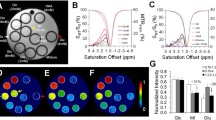Summary
Recent advances in magnetic resonance spectroscopy permit noninvasive study of brain metabolism in vivo,31P spectroscopic imaging being the method for evaluation of localized phosphorous metabolism. Experimentally, an ischemic-hypoxic brain insult is characterized by depletion of high energy metabolites. These changes are seen immediately after an ischemic insult. We had the opportunity of carrying out31P spectroscopic imaging of hyperacute cerebral infarction, while MRI and CT were negative. Cerebral infarction of the middle cerebral artery territory was suggested by31P spectroscopic imaging, which was closely consistent with a later-develo** region of low density on CT. In cerebral infarction, early detection of the lesion is a useful pointer to the patient's prognosis, making31P spectroscopic imaging a potential tool.
Similar content being viewed by others
References
Brant-Zawadzki M, Barkowski HM, Pitts LH, Hylton NM, Nishimura MC, Crooks LE (1984) NMR in experimental cerebral edema: Value of T1 and T2 calculations. AJNR 5:125–129
Brant-Zawadzki M, Weinstein P, Bartkowski H, Moseley M (1987) MR imaging and spectroscopy in clinical and experimental cerebral ischemia: a review. AJNR 8:39–48
Bryan RN, Willcott MR, Schneiders NJ, Ford JJ, Derman HS (1983) Nuclear magnetic resonance. Evaluation of stroke. A preliminary report. Radiology 149:189–192
DeWitt LD, Buonanno FS, Kistler JP, Brady TJ, Pykett IL, Goldman MR, Davis KR (1984) Nuclear magnetic resonance imaging in evaluation of clinical stroke syndromes. Ann Neurol 16: 535–545
Eguchi T, Iai S, Nagane M, Taniguchi T, Kawamoto S, Ouchi T, Umeda M (1988) The diagnosis of the pathological conditions of cerebral infarction in an acute stage through multi-modality examinations including MRS. Prog CT 10:509–515
Fujimoto T, Tsuji T, Nakano T, Noguchi S, Uchida T, Okada A, Sasahira M, Uwata O, Watanabe K, Osame M, Asakura T, Igata A, Miyazaki T, Hasegawa J, Iriguchi N (1988)1H imaging and31P spectroscopic imaging in Alzheimer's disease. Abstracts of International symposium MRI update 1988. The second Kumamoto University — UCLA Radiology Symposium, Kumamoto, Japan, p 93
Fujimoto T, Noguchi S, Nakano T, Okada A, Sasahira M, Uwata O, Watanabe K, Osame M, Igata A, Asakura T (1989) MRS of Alzheimer's disease in presenile stage. Abstracts of the 12th Annual Meeting of the Japanese Society of CNS Computerized Tomography. Kagoshima, Japan, p 116
Fukuda O, Sato S, Suzuki T, Endo S, Takaku A (1989) MRI of acute cerebral infarction. Neurol Surg 17:31–36
Go KG, Edzes HT (1975) Water in brain edema. Observations by the pulsed nuclear magnetic resonance technique. Arch Neurol 32:462–465
Inoue Y, Takemoto K, Miyamoto T, Yoshikawa N, Taniguchi S, Saiwai S, Nishimura Y, Komatsu T (1980) Sequential computed tomography scans in acute cerebral infarction. Radiology 135: 655–662
Kato H, Kogure K, Ohotomo H, Izumiyama M, Tobita M, Matsui S, Yamamoto E, Kohno H, Ikebe Y, Watanabe T (1986) Magnetic resonance imaging of experimental cerebral ischemia: correlations between NMR parameters and water content. Brain Nerve 38:295–302
Lenkinski RE, Holland GA, Allman T, Vogele K, Kresel HY, Grossman RI, Charles HC, Engeseth HR, Flamig D, Macfall JR (1988) Integrated MR imaging and spectroscopy with chemical shift imaging of 31-P at 1.5 T: Initial clinical experience. Radiology 169:201–206
Maudsley AA, Hilal SK, Simon HE, Wittekoek S (1984) In vivo MR spectroscopic imaging with P-31. Radiology 153:745–750
Miyazaki T, Hasegawa J, Iriguchi N, Takeda J (1988) 31 P-SIDAC. Jpn J Magn Reson Med 8 [Suppl 2]:274
Miyazaki T, Yamamoto T, Iriguchi N, Ueshima Y, Hasegawa J, Yamai S, Hikida K, Manabe A, Toyoshima H, Maki T (1989) Spectroscopic imaging by dephasing amplitude changing (SIDAC). Radiat Med 1:1–5
Naruse S, Horikawa Y, Tanaka C, Hirakawa K, Nishikawa H, Koizuka I, Takada S, Watari H (1983) In vivo31P NMR studies on cerebral infarction using topical magnetic resonance (TMR) —Time course of high energy phosphorus compunds content in ischemic and recirculated brain. Brain Nerve 35:603–609
Sasahira M, Uchimura K, Kawahara Y, Okada A, Fujimoto T, Nakano T, Asakura T, Osame M, Igata A, Miyazaki T, Hasegawa J, Iriguchi N (1988) Phosphorous spectroscopic imaging of human brain. Abstracts of International symposium MRI update 1988. The second Kumamoto University — UCLA Radiology Symposium, Kumanoto, Japan, p 94
Sasahira M, Uchimura K, Okada A, Fujimoto T, Asakura T, Kawahara Y, Osame M, Miyazaki T, Hasegawa J, Iriguchi N (1989) Clinical analysis of31P spectroscopic imaging of brain tumors. Abstracts of the 12th Annual Meeting of the Japanese Society of CNS Computerized Tomography, Kagoshima, Japan, p 191
Sasahira M, Uchimura K, Kawahara Y, Fujimoto T, Asakura T, Osame M, Miyazaki T, Hasegawa J, Iriguchi N (1989)31P spectroscopic imaging of intracerebral hemorrhage. Jpn J Magn Reson Med 9 [Suppl 1]:143
Sasahira M, Uchimura K, Fujimoto T, Asakura T, Iriguchi N (1989) Phosphorous spectroscopic imaging of human brain tumors. Magn Reson Imaging 7 [Suppl 1]:130
Sipponen JT, Kaste M, Ketonen L, Sepponen RE, Katevuo K, Sivula A (1983) Serial nuclear magnetic resonance (NMR) imaging in patients with cerebral infarction. J Comput Assist Tomogr 7:585–589
Uchimura K, Sasahira M, Kawahara Y, Okada A, Fujimoto T, Asakura T, Osame M (1989)31P-chemical shift imaging of cerebral infarction and cerebral hemorrhage — evaluation of energic metabolism using SIDAC method. Abstracts of the 12th Annual Meeting in the Japanese Society of CNS Computerized Tomography, Kagoshima, Japan, p 185
Uchimura K, Sasahira M, Kawahara Y, Okada A, Fujimoto T, Asakura T, Osame M, Miyazaki T, Hasegawa J, Iriguchi N (1989)31P chemical shift imaging of the human brain, with special reference to acute large cerebral infarction. Igaku no Ayumi 148:369–370
Author information
Authors and Affiliations
Rights and permissions
About this article
Cite this article
Sasahira, M., Uchimura, K., Yatsushiro, K. et al. Early detection of cerebral infarction by31P spectroscopic imaging. Neuroradiology 32, 43–46 (1990). https://doi.org/10.1007/BF00593940
Received:
Accepted:
Issue Date:
DOI: https://doi.org/10.1007/BF00593940




